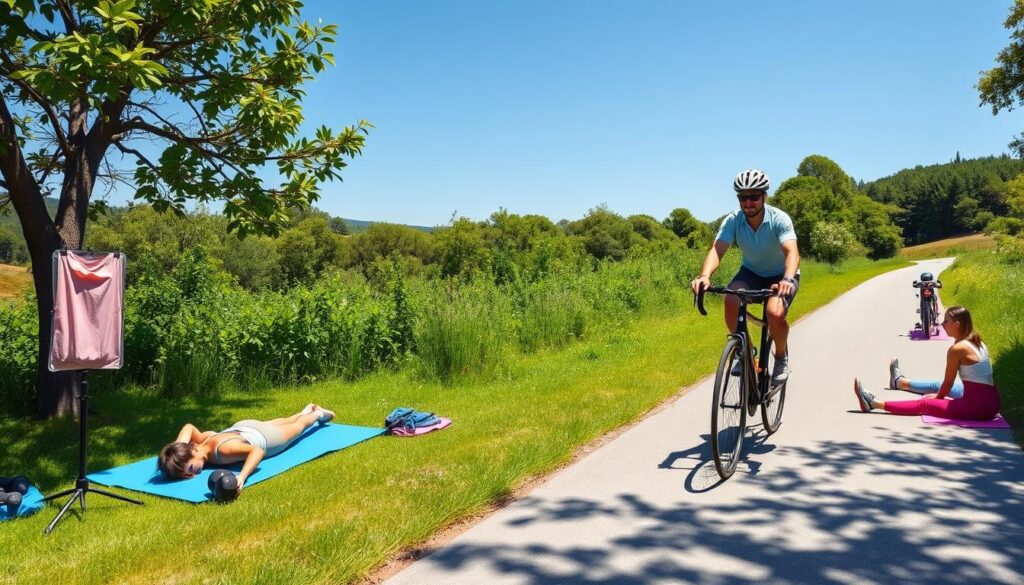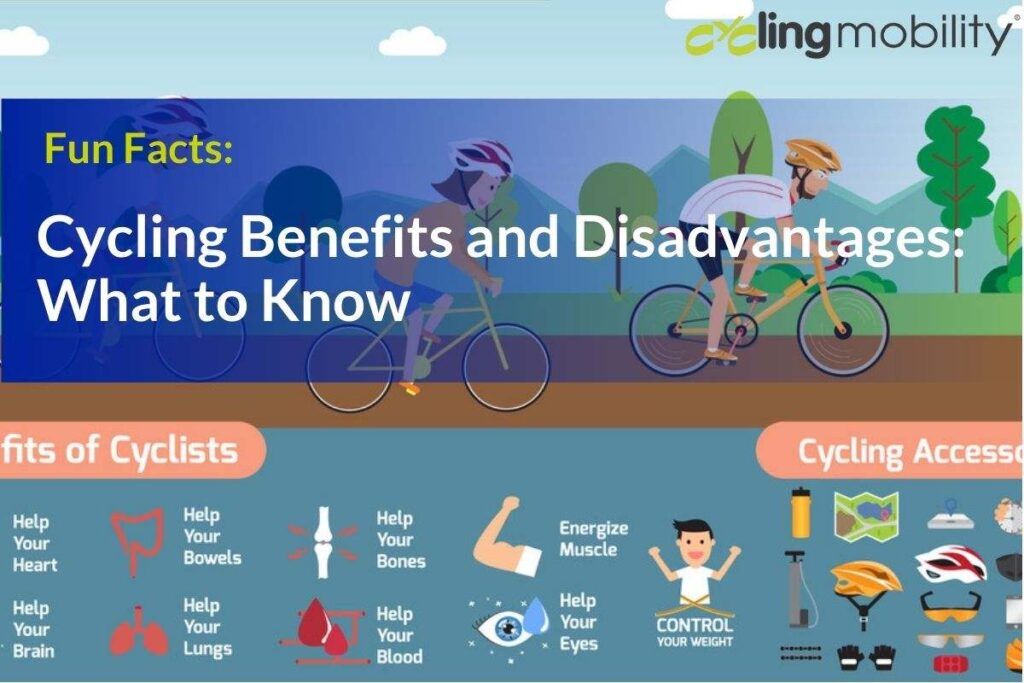Did you know 67% of recreational cyclists feel pain while riding? Yet, 81% still enjoy it. A 2023 study found this interesting fact. It shows cycling is both rewarding and challenging.
Knowing the cycling benefits and drawbacks is key for those wanting to try it. This article will cover the cycling benefits and disadvantages of cycling. We’ll look at how it affects your health, fitness, and happiness. We’ll also talk about the risks like injuries and how weather can impact them.

Key Takeaways
- Cycling can significantly enhance cardiovascular health.
- Engaging in cycling may improve your mental well-being.
- There are potential risks associated with cycling, including injuries.
- Weather conditions can influence cycling activities.
- Cycling promotes an eco-friendly lifestyle compared to driving.
- Understanding both benefits and drawbacks helps in making informed cycling choices.
Introduction to Cycling
Cycling is a great way for everyone to stay active. It’s good for your health, no matter your fitness level. Whether you ride for fun, to get around, or to compete, it’s a great choice.
Regular cycling can boost your metabolism. This helps build muscle and manage weight. Even if you’re not very active, cycling can still help you a lot. Indoor cycling is especially good for those who can’t ride outdoors.
Cycling can also improve your health in the long run. It can lower the risk of death for people with diabetes by up to 35%. It’s also good for the heart and blood pressure.
But, it’s important to know the downsides of cycling too. Riding outside can be risky, with accidents and injuries possible. In the U.S., over 726 cyclists died and 50,000 got hurt in just one year.
So, cycling is more than just a way to get around. It lets you enjoy nature, get healthier, and live a better life. Make it a part of your daily routine for many benefits.
Understanding the 9 Cycling Benefits
Cycling offers many benefits that go beyond just physical health. It can improve your stamina, strength, and help the environment. Knowing the pros and cons helps you choose better ways to travel and stay fit.
Physical Health Benefits
Cycling boosts your heart health. The CDC says you need 150 minutes of cardio a week. Cycling on flat roads meets this need.
When you ride hills or go over 10 mph, it gets even better. For example, a 155-pound person burns 298 calories in 30 minutes at 12 to 13 mph. It keeps cholesterol levels healthy, boosts stamina, and lowers disease risk.
Mental Well-being and Stress Relief
Cycling is great for your mind, too. It reduces stress, improves mood, and helps you sleep better. A study in Extreme Physiology and Medicine showed that outdoor exercise makes sticking to a routine easier.
Outdoor workouts, like cycling, are key for mental health. They help keep your emotions balanced.
Weight Management and Body Composition
Cycling helps with weight control by burning calories and fat. It’s not a weight-bearing exercise, so it doesn’t build bone density. But, it’s still good for keeping a healthy body shape.
Regular cycling aids in long-term weight loss. It supports your fitness goals.

Boosting Cardiovascular Health
Regular cycling is great for your heart. It makes your heart stronger, lowers blood pressure, and cuts down heart disease risks. Cycling for 30 minutes a day boosts blood flow, endurance, and heart health.
Your body gets better at using oxygen. This improves your overall fitness.
Enhancing Lower Body Strength
Cycling works your lower body muscles like the legs and glutes. It’s a low-impact exercise that builds muscle without hurting your joints. It’s good for people of all fitness levels.
It makes your legs stronger, and improves balance, and stability. Cycling offers many benefits and some drawbacks.
Eco-friendly Transportation
Cycling is a green way to travel that significantly reduces environmental impact. Unlike cars, it produces no emissions, helping to improve air quality and lower carbon footprints. More cycling means less pollution, contributing to a healthier environment.
By choosing to cycle, you’re actively reducing your environmental impact. It’s a simple way to show care for the planet and make a smart choice for a greener, more sustainable future.

Social Interaction and Community
Cycling is a great way to meet new people and make friends. Joining a local cycling group lets you connect with others who love biking. You’ll form lasting friendships that go beyond the trails.
Going on group rides or attending events makes cycling more fun. It also pushes you to try new things. You’ll feel like you belong, which is good for your mind. Riding with others turns solo adventures into unforgettable experiences.
The cycling community offers many chances to work together and learn new skills. Some benefits include:
- Improved social skills through regular interaction
- Increased motivation with supportive peers
- Opportunities for networking and community service
In short, cycling is more than just a hobby. It’s a way to connect with others. By joining a cycling community, you make your rides better and help create a positive space for everyone.

Time Efficiency and Convenience
Cycling is a fast way to get around, especially in busy cities. It lets you move through tight spots and skip traffic jams. This means you can get to your destination quicker than by car or bus.
Using a bike makes your daily commute easier. You can fit bike rides into your busy schedule. No more waiting for buses or stuck in car lines. Imagine biking to work and feeling refreshed and ready for the day.
This way of getting around is not only practical but also good for short trips. Research shows many people still choose cars for distances under 5 km. But cycling is a better option for these short journeys.
- Keeping a bike costs much less than a car, saving you about $1,700 a year if you bike 10 km each way to work.
- Most trips under 5 km are by car, even though cycling is better for this distance. This shows a big chance for saving time.
- Many homes are closer to bike-friendly public transport than walking distance. This highlights how cycling can make getting around easier.

Combining Cycling with Other Forms of Exercise
Cycling is great for your fitness. To get even more benefits, try cycling with other exercises. Mixing different activities makes your health routine better. It shows that different fitness routines can boost your performance.
Cross-training adds variety to your workouts and prevents burnout. Activities like running, swimming, or strength training work muscles cycling doesn’t. Strength training improves your bike control and stability.
Workouts like hiking or cross-country skiing are good for bones. They help with muscle recovery and keep bones strong. This variety helps avoid injuries and improves your cycling over time.

- Try moderate exercises like yoga or maintenance strength training to support your cycling journey.
- Engaging in cross-training during the off-season leads to significant performance improvements when cycling resumes.
- Maintaining a flexible training schedule creates opportunities for enhancing your fitness levels without compromising time.
In summary, mixing cycling with other exercises makes your fitness journey better. Add a variety of activities to your weekly routine for the best health benefits.
Exploring the 3 main disadvantages of cycling
While cycling offers many benefits, it’s important to recognize that it also has some downsides. From physical discomforts like a sore bum to injury risks, safety concerns, and weather challenges, cycling isn’t always the perfect option. So, these three main points may help you consider potential drawbacks before committing to cycling as a regular mode of transportation or exercise.
Injury Risks and Safety Concerns
Cycling can be risky, especially in busy areas. Falls or crashes can cause serious injuries. To stay safe, always wear a helmet and use clear signals. Also, be mindful of your surroundings and follow traffic rules.
Choosing safer routes, like bike paths, can also improve your safety.
Weather Dependence
Weather can greatly affect cycling. Bad weather like rain or snow can make it uncomfortable and dangerous. Always check the weather forecast before riding.
Having the right gear for sudden weather changes is also important.
Cost and Accessibility Issues
Cycling can be expensive, especially for the initial costs of a good bike and gear. While it saves money on transport, the upfront costs can be high. Not everyone has access to safe cycling areas, which can limit its use.

Cycling is a great way to improve your health. It boosts your heart health and mental well-being. Studies show that biking can add years to your life, thanks to its many benefits.
But, cycling isn’t perfect. You might face weather issues and safety risks. Still, there are indoor and outdoor options for everyone. This means you can find a way to bike that fits your life.
By choosing to bike, you get to enjoy many benefits. It’s good for your body and mind. So, why not make biking a part of your routine? Your health will likely thank you!
FAQs
What are the main benefits of cycling?
Cycling is great for your heart, legs, and mind. It helps manage weight and can lower cholesterol. It also reduces stress and anxiety, making you happier.
What are the disadvantages of cycling?
Cycling can be risky, especially on roads. You need good weather and might spend money on bikes and gear. Always wear safety gear to avoid injuries.
Can cycling improve my mental health?
Yes, it can! Cycling reduces stress and boosts your mood. The endorphins it releases improve your mental health and happiness.
Is cycling a good option for commuting?
Yes, it’s a fast and flexible way to get to work. It’s great in busy areas and lets you plan your day better.
How does cycling benefit the environment?
Cycling is good for the planet. It cuts down on carbon emissions compared to cars. By cycling, you help the environment.
Can I combine cycling with other exercises?
Definitely! Cycling pairs well with running, swimming, and strength training. It makes your workout routine better and lowers injury risks.
Can cycling be enjoyed by people of all fitness levels?
Yes, cycling is for everyone. It’s perfect for fun, getting around, or competing. It’s a healthy activity for all.






